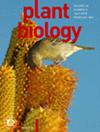Anther mimicry in an African orchid pollinated by pollen-feeding beetles
IF 3.6
3区 生物学
Q1 PLANT SCIENCES
引用次数: 0
Abstract

非洲兰花的花药拟态,由取粉的甲虫授粉。
许多种类的花都有黄色的斑纹,看起来像花药或花粉,吸引寻找花粉的昆虫(通常是雌蜂)的注意。我们调查了Disa similis的一个假定的花药模仿案例,Disa similis是一种无花蜜的淡紫色花朵,在唇瓣和侧花瓣的尖端有明显的黄色标记。通过对南非夸祖鲁-纳塔尔省草原上的访花者的直接观察,研究了相似金蝇。用光谱法分析了兰科植物及其同域种花部的光谱反射率。授粉的成功与花瓣顶端的颜色操纵和花期有关。估计了总体花粉传递效率和育种系统,以确定坐果对传粉者的依赖。花无香味,由食粉甲虫Isoplia lasiosoma通过咀嚼黄色的花瓣尖来授粉。整体颜色类似于甲虫取食花粉的共花植物,花瓣顶端的黄色吸收紫外线的颜色与花药和花粉的颜色相匹配。用紫色涂料覆盖黄色斑纹或将其去除会降低授粉成功率。花粉的去除和沉积与花期密切相关。植物是自相容的,依赖于授粉者的访问果实集。先前对兰花和其他植物的研究表明,蜜蜂或苍蝇作为传粉者不会对花朵造成物理损害。因此,由取食花粉的甲虫授粉和它们消耗花药状的花瓣尖是意想不到的和新颖的发现。
本文章由计算机程序翻译,如有差异,请以英文原文为准。
求助全文
约1分钟内获得全文
求助全文
来源期刊

Plant Biology
生物-植物科学
CiteScore
8.20
自引率
2.60%
发文量
109
审稿时长
3 months
期刊介绍:
Plant Biology is an international journal of broad scope bringing together the different subdisciplines, such as physiology, molecular biology, cell biology, development, genetics, systematics, ecology, evolution, ecophysiology, plant-microbe interactions, and mycology.
Plant Biology publishes original problem-oriented full-length research papers, short research papers, and review articles. Discussion of hot topics and provocative opinion articles are published under the heading Acute Views. From a multidisciplinary perspective, Plant Biology will provide a platform for publication, information and debate, encompassing all areas which fall within the scope of plant science.
 求助内容:
求助内容: 应助结果提醒方式:
应助结果提醒方式:


